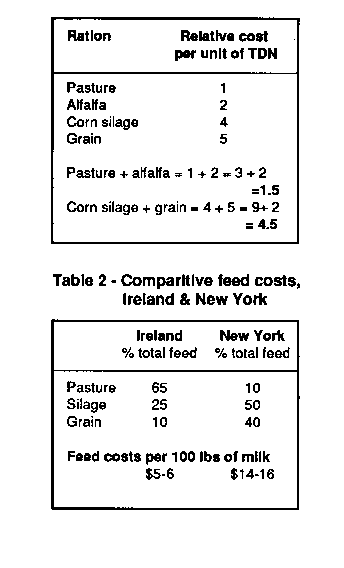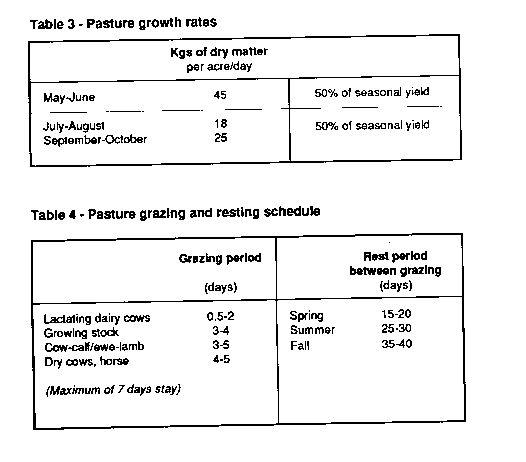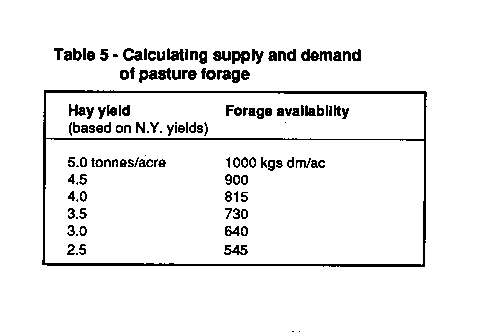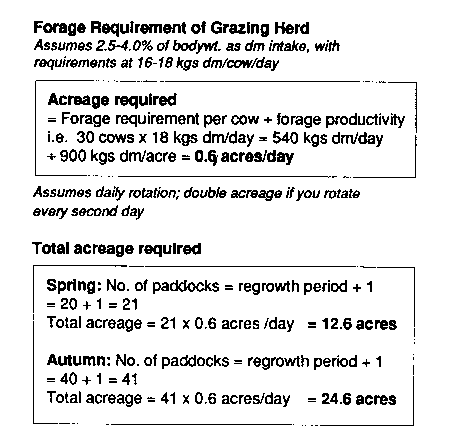
Sustainable Farming Index | Virtual Library | Magazine Rack
Search
| Ecological Solutions Roundtable
by Hugh Maynard
The Citrus Belt, the Cotton Belt and the Corn Belt are all commonly known deliniations of North American agricultural regions; now Darryl Emmick wants you to know about the Forage Belt and how he believes dairy and other livestock farmers can improve their farm's bottom line through better utilization of that forage resource with better pasture management.
Emmick is a United States Department of Agriculture (USDA) soil conservation specialist based in western New York state, and he spoke in late March at several livestock producer information days in Quebec.
He notes that each region has climate and soil conditions suited to the production of certain crops and that farms in those regions ought to emphasize these types of crops. It's not a new idea, as Emmick illustrates with a 100-year old USDA map deliniating the four 'belts' across N. America; and he's not dogmatic to the extent that north-eastern farmers should not grow corn or soybeans at all.
However, he points out that the northern U.S. states and south-eastern Canadian regions are ideal areas for forage production. Agriculture is in trouble, he maintains, because of the complexity and over-capitalization that has resulted from trying to produce all kinds of commodities in all kinds of places.
"Equipment that's sitting doing nothing doesn't pay, and most farmers producing corn for livestock have too much equipment," Emmick said. He points to corn silage production in N.Y. as an example; the break even point on all costs is a yield of 16 tons per acre, yet the average yield is 13-14 tons per acre.
"This is only 80% of the break even yield, so for every $100.00 spent, the return is only $80.00," he explained. Despite these economics, Wisconsin and N.Y. are the number one and two corn silage states respectively.
Emmick suggests that corn production is best left to farmers in the 'belt', or at least to cash croppers who can make the best utilization of equipment. He maintains that even with the necessity of feeding livestock year-round, a 200 day pasture season and legume forage based ration is approximately one third less expensive than a grain based one (see Table 1.)
He has spent several periods of time studying pasture management in Ireland, where two-thirds of the ration is provided by pasture at one third of the cost in N.Y. (see Table 2.)
"Every farm that went to pasture saved more money than with confinement housing," Emmick says about N.Y. farmers who have adopted greater pasture utilization, noting a potential savings range of $42 to $290 per cow, depending on herd production levels.
Improved management is the key to pasture success, adds Emmick: "A poor pasture is not a poor pasture, it's a crop failure. Quantity and quality is not an accident, it takes the same kind of planning and management as for any other successful crop."
Tillering is one of the most important aspect of extended season pasturing and requires a planned grazing system to make it work. Tillering is the regrowth of the plant, a process triggered by access of sunlight to the plant base at groundlevel; ungrazed plants don't regrow until the first leaf growth wilts in the autumn, allowing sunlight to reach the plant's base.
Grazing and mechanical harvesting (for hay and haylage) imitate the natural tillering stimulus by allowing sunlight to reach the plant base when the upper plant body is removed. Other factors affecting regrowth include hormonal and root reserves.
Emmick estimates that managed pastures can provide 9 tonnes of forage per hectare per season, enough to provide the forage requirements of one dairy cow based on 16-18 kgs of dry matter per day.
The challenge is balancing the grazing and haying schedules amongst the fields that have twice the growth rate in May-June than in July-October (see Table 3.) Planning, therefore, becomes essential, especially estimating the demand and supply of pasture forage and the number of divisional paddocks required (see formula in Table 5.)
The most workable formula is to graze half the fields during the first two months of the season, and crop the balance for hay or haylage. Once growth rates slow down, graze all the fields during the last four months. Similarly, the time period that livestock are allowed to graze a paddock and the rest period in between grazing is shortest in the spring months, and longer in the summer and fall (see Table 4.)
Grass should ideally be 6-8" high when grazing commences, and between 1.5-3" when the cows are taken out. If left to grow too high, the grass will go to waste and most importantly, won't re-tiller. If grazed too short, the stand can suffer from drought and trampling. "Uncontrolled defoliation is the biggest enemy of pastures because animals will take the best and leave the rest," Emmick said.
Laneways and watering facilities are important adjuncts to rotational pasture systems, allowing the easy movement of animals between paddocks without having to come back to a central location. Moveable fencing systems and watering facilities have greatly improved in recent years, making these management aspects much easier.
"Some farmers fix up the laneway for tractors but leave dairy cows to wallow in mud up to their bellies. Cows make money, not the tractors," Emmick exclaimed.
He suggested that shade was not an absolute necessity for pasture systems, and sometimes it can act as an impediment. He said cows will tolerate up to 85¡ F in the sun, with excessive temperatures at this level only occurring a few times a year in northern latitudes. If given shade, cows will congregate there, leading to dirty conditions and potential pest problems. In addition, they spend less time grazing, frustrating the best laid of pasture management plans. One compromise solution is to give access to shade only during the hours when the sun is strongest, i.e. 1:00-4:00 p.m.
As with the introduction of other new management programs, time is required to get operations running smoothly. As the system is implemented, the productivity of pastures improve, resulting in more efficient use of land.
Table 1 - Relative feed costs for dairy herds



Note: assumes standard regrowth for spring and summer; pastures are often not in as good shape as hay stands, adjust accordingly.

Copyright © 1992 REAP Canada.
Reprinted with permission. All rights reserved.
Info Request | Services | Become EAP Member | Site Map
Give us your comments about the EAP site
Ecological Agriculture Projects, McGill University (Macdonald
Campus),
Ste-Anne-de-Bellevue, QC, H9X 3V9 Canada
Telephone:
(514)-398-7771
Fax:
(514)-398-7621
Email: info@eap.mcgill.ca
To report problems or otherwise comment on the structure of this site, send mail to the Webmaster